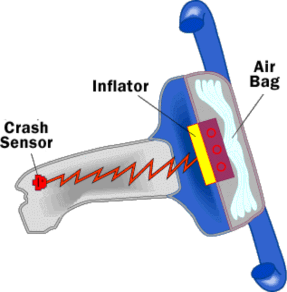Airbags
Airbags are key components in automotive safety systems, and, although we cannot see them perform under normal conditions with the naked eye, they soften the impact of collisions by keeping passengers from contacting the steering wheel, dashboard, front glass, and other parts of the automobile.
Modern vehicles may contain multiple airbag modules in various side and frontal locations of the passenger seating positions, and sensors may deploy one or more airbags in an impact zone at variable rates based on the type, angle and severity of impact; the airbag is designed to only inflate in moderate to severe frontal crashes.


How airbag works
The goal of an airbag is to slow the passenger's forward motion as evenly as possible in a fraction of a second. There are three parts to an airbag that help to accomplish this feat:
The bag itself is made of a thin, nylon fabric, which is folded into the steering wheel or dashboard or, more recently, the seat or door.
The sensor is the device that tells the bag to inflate. Inflation happens when there is a collision force equal to running into a brick wall at 10 to 15 miles per hour (16 to 24 km per hour). A mechanical switch is flipped when there is a mass shift that closes an electrical contact, telling the sensors that a crash has occurred. The sensors receive information from anaccelerometer built into a microchip.
The airbag's inflation system reacts sodium azide (NaN3) with
potassium nitrate (KNO3) to producenitrogen gas. Hot blasts of the nitrogen inflate the airbag.
